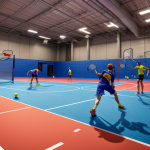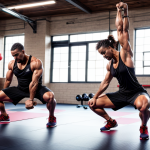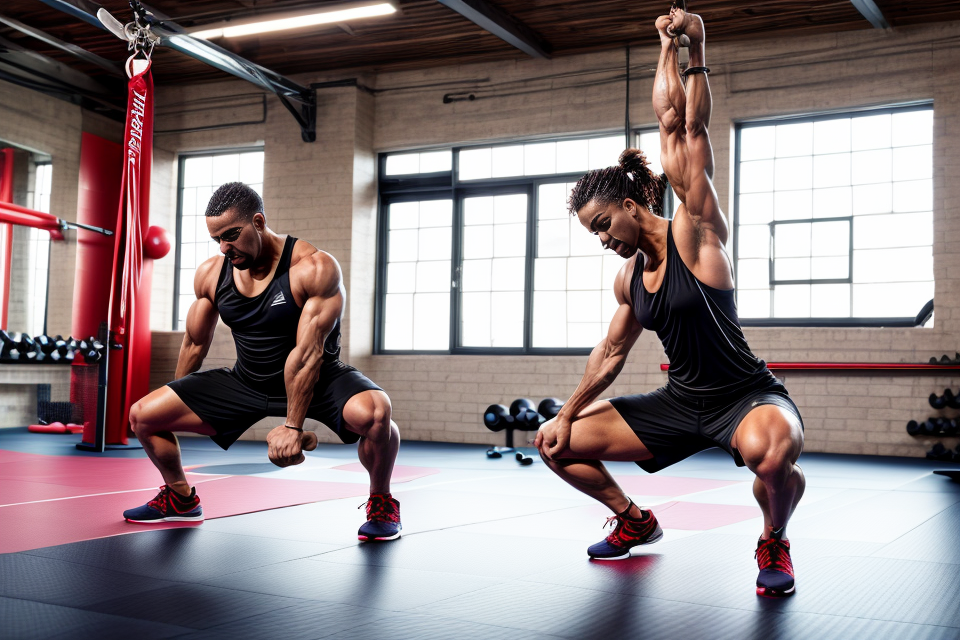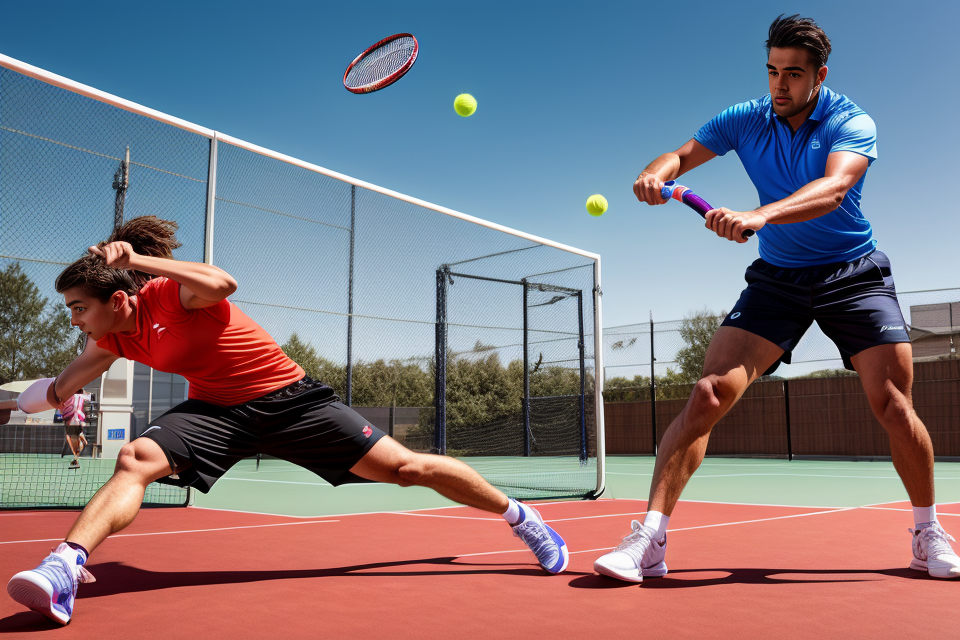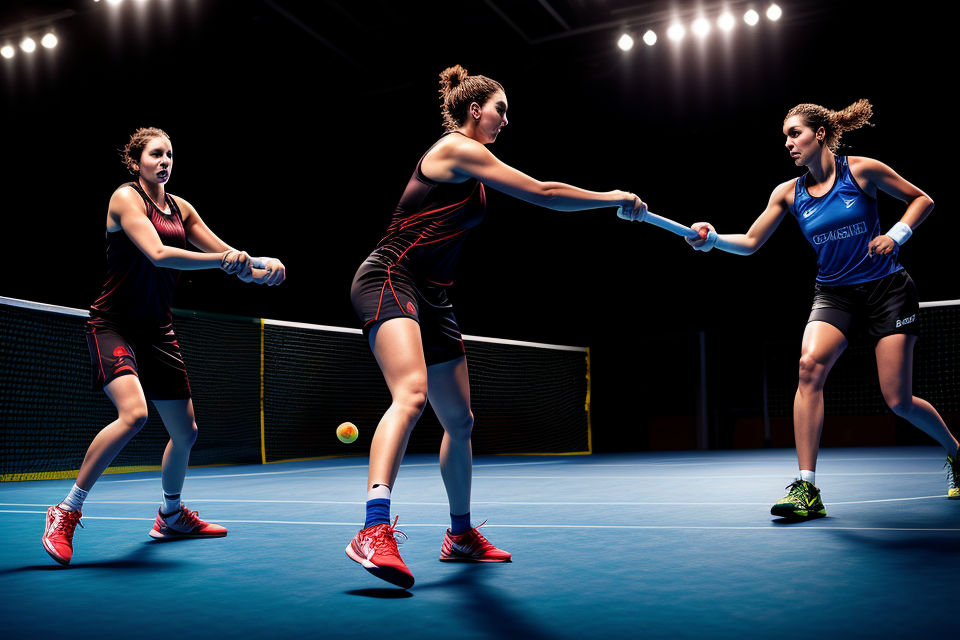Squash is a high-intensity racquet sport that requires explosive movements, agility, and endurance. To excel in this sport, it is essential to incorporate strength training exercises into your fitness routine. However, it can be challenging to know where to start, especially if you are new to strength training. In this comprehensive guide, we will discuss the best strength training exercises for squash players, how to create a tailored workout plan, and provide tips for injury prevention. Whether you are a beginner or an experienced player, this guide will help you to effectively strength train for squash and improve your on-court performance.
Understanding the Importance of Strength Training for Squash
The Connection Between Strength and Squash Performance
In order to perform at a high level in squash, it is essential to develop both strength and endurance. Strength training can help players improve their overall physical fitness, increase power and speed on the court, and reduce the risk of injury. Additionally, strength training can also help players maintain a healthy body weight, which is important for optimal performance in squash.
Benefits of Strength Training for Squash Players
Strength training has numerous benefits for squash players, including:
- Improved power and speed on the court
- Increased muscular endurance
- Enhanced balance and stability
- Reduced risk of injury
- Improved overall physical fitness
- Increased mental focus and concentration
Key Muscle Groups to Target in Strength Training for Squash
To optimize strength training for squash, players should focus on exercises that target the muscles used most frequently in the sport, including:
- Legs: quadriceps, hamstrings, glutes, and calves
- Core: abdominals and lower back muscles
- Upper body: shoulders, arms, and chest
By targeting these muscle groups, players can improve their overall power and speed on the court, as well as their ability to move and change direction quickly.
Examples of Strength Training Exercises for Squash
There are many exercises that can be used to effectively strength train for squash, including:
- Squats and lunges: to strengthen the legs and improve lower body power
- Planks and sit-ups: to strengthen the core and improve stability
- Push-ups and bench press: to strengthen the upper body and improve shoulder and arm strength
The Importance of Proper Form and Technique in Strength Training for Squash
Proper form and technique are essential in strength training for squash, as incorrect form can lead to injury and reduced effectiveness. Players should seek guidance from a qualified personal trainer or fitness professional to ensure they are performing exercises with proper form and technique.
Overall, incorporating strength training into a training regimen can help squash players improve their performance on the court, reduce the risk of injury, and maintain a healthy body weight.
Key Muscle Groups to Focus on for Squash
As a professional squash player, it is essential to understand the importance of strength training to enhance your performance on the court. Strength training helps improve your muscular strength, power, and endurance, which are all critical aspects of playing squash. To optimize your strength training routine, it is essential to focus on specific muscle groups that are critical to your game. In this section, we will discuss the key muscle groups to focus on for squash.
Upper Body Muscle Groups
The upper body is essential in squash, as it is used to control the racket and maintain balance during the game. Some of the key muscle groups to focus on include:
- Shoulders: Strong shoulders help improve your racket control and stability during the game.
- Chest: A strong chest muscle helps improve your ability to hit powerful shots and maintain balance during the game.
- Triceps: Strong triceps help you maintain control over the racket and hit accurate shots.
- Biceps: Strong biceps help improve your grip on the racket and maintain control during the game.
Lower Body Muscle Groups
The lower body is also crucial in squash, as it is used for movement and balance on the court. Some of the key muscle groups to focus on include:
- Quadriceps: Strong quadriceps help improve your movement and balance on the court.
- Hamstrings: Strong hamstrings help improve your speed and power during the game.
- Glutes: Strong glutes help improve your balance and stability on the court.
- Calves: Strong calves help improve your mobility and agility on the court.
Core Muscle Groups
The core muscles are also essential in squash, as they help improve your balance, stability, and power during the game. Some of the key muscle groups to focus on include:
- Abdominals: Strong abdominals help improve your balance and stability on the court.
- Back muscles: Strong back muscles help improve your posture and maintain control during the game.
- Obliques: Strong obliques help improve your balance and stability on the court.
In conclusion, focusing on these key muscle groups is essential for any squash player looking to improve their performance on the court. By incorporating strength training exercises that target these muscle groups, you can enhance your muscular strength, power, and endurance, which are all critical aspects of playing squash.
Assessing Your Current Fitness Level
Conducting a Fitness Assessment for Squash
To effectively strength train for squash, it is important to first assess your current fitness level. This assessment will help you determine your strengths and weaknesses, as well as identify areas that need improvement.
There are several components to a fitness assessment for squash, including:
- Cardiovascular Endurance: This is the ability of your heart, lungs, and blood vessels to deliver oxygen to your muscles during physical activity. A squash match can be a high-intensity, aerobic activity, so it is important to have good cardiovascular endurance.
- Strength and Power: Squash requires explosiveness and power in your shots, so it is important to assess your strength and power in your upper and lower body.
- Flexibility and Mobility: Good flexibility and mobility are important for moving around the court and executing shots effectively.
- Balance and Coordination: These are important for maintaining stability on the court and avoiding injuries.
To conduct a fitness assessment for squash, you can follow these steps:
- Warm-up: Start with a warm-up to prepare your body for the assessment. This can include light cardio and dynamic stretching.
- Cardiovascular Endurance Test: You can measure your cardiovascular endurance by performing a maximal exercise test, such as running or cycling, and measuring your heart rate and time.
- Strength and Power Tests: To assess your strength and power, you can perform exercises such as squats, lunges, and jumps, and measure your one-rep max or power output.
- Flexibility and Mobility Tests: You can measure your flexibility and mobility by performing exercises such as hamstring stretches, hip openers, and shoulder circles.
- Balance and Coordination Tests: To assess your balance and coordination, you can perform exercises such as single-leg squats, single-leg deadlifts, and balance exercises on a balance board.
By conducting a fitness assessment for squash, you can gain a better understanding of your current fitness level and identify areas that need improvement. This will help you develop a targeted strength training program that will improve your performance on the court.
Determining Your Starting Point
Before you begin your strength training journey for squash, it is crucial to assess your current fitness level. This will help you understand your body’s current state and design a workout plan that suits your needs.
Here are some steps to help you determine your starting point:
- Conduct a Fitness Assessment
The first step in determining your starting point is to conduct a fitness assessment. This can include tests such as a 1.5-mile run, sit-ups, push-ups, and squats. These tests will help you identify your strengths and weaknesses and provide a baseline for your progress. - Evaluate Your Injury History
Next, evaluate your injury history. If you have a history of injuries, it is essential to work with a qualified fitness professional to develop a personalized training program that takes into account your limitations and risk factors. - Identify Your Goals
Identify your goals for squash. Are you looking to improve your strength, endurance, or both? This will help you focus your training efforts on the areas that matter most to you. - Determine Your Availability
Determine your availability for training. Squash training requires a significant time commitment, so make sure you have enough time to dedicate to your workouts. - Consult with a Professional
Consult with a professional fitness trainer or coach to help you design a training program that meets your needs. They can help you create a customized plan that will help you achieve your goals and prevent injury.
By following these steps, you can determine your starting point and design a strength training program that will help you achieve your goals in squash.
Developing a Strength Training Program
Setting Goals for Your Strength Training Program
When it comes to developing a strength training program for squash, setting clear and specific goals is essential. This will help you to focus your efforts and ensure that you are making progress towards your desired outcomes. Here are some steps to follow when setting goals for your strength training program:
- Identify your strengths and weaknesses: The first step in setting goals for your strength training program is to identify your strengths and weaknesses as a squash player. This will help you to understand where you need to focus your efforts and what areas you need to improve.
- Set SMART goals: When setting goals for your strength training program, it’s important to make sure they are specific, measurable, achievable, relevant, and time-bound. This will help you to create a goal that is realistic and achievable, and will give you a clear target to work towards.
- Prioritize your goals: With so many different areas to focus on, it’s important to prioritize your goals. Start by identifying the most important goals for your squash performance, and work on these first.
- Create a plan: Once you have identified your goals and prioritized them, it’s time to create a plan for achieving them. This should include the specific exercises you will do, the number of sets and reps you will complete, and the frequency with which you will train.
- Track your progress: As you work towards your goals, it’s important to track your progress. This will help you to see how far you have come, and will give you motivation to continue working towards your goals.
By following these steps, you can set clear and specific goals for your strength training program, and ensure that you are making progress towards your desired outcomes. Whether you are a beginner or an experienced squash player, setting goals is an essential part of developing a successful strength training program.
Creating a Comprehensive Workout Plan
To effectively strength train for squash, it is important to create a comprehensive workout plan that targets the muscles used in the sport. This plan should include a combination of strength training exercises and drills that specifically target the muscles used in squash, such as the legs, core, and upper body.
When creating a workout plan, it is important to consider your current fitness level and any existing injuries or limitations. It is also important to allow for proper recovery time between workouts and to gradually increase the intensity and difficulty of the exercises over time.
When developing a strength training program for squash, it is important to focus on exercises that target the muscles used in the sport, such as the legs, core, and upper body. Exercises such as lunges, squats, and planks can help to improve leg strength and endurance, while exercises such as push-ups and rows can help to build upper body strength.
It is also important to incorporate drills that simulate the movements used in squash, such as jumping and changing direction quickly. These drills can help to improve agility and footwork, which are crucial skills for success in the sport.
Additionally, it is important to incorporate exercises that target the muscles used in the sport, such as the legs, core, and upper body. Exercises such as lunges, squats, and planks can help to improve leg strength and endurance, while exercises such as push-ups and rows can help to build upper body strength.
When creating a comprehensive workout plan, it is important to consider your current fitness level and any existing injuries or limitations. It is also important to allow for proper recovery time between workouts and to gradually increase the intensity and difficulty of the exercises over time.
Incorporating Cardio and Endurance Training
Incorporating cardio and endurance training into your strength training program is crucial for improving your overall fitness and performance on the squash court. Here are some tips for incorporating cardio and endurance training into your routine:
- Start with a warm-up: Before starting any cardio or endurance training, it’s important to warm up your muscles to prevent injury and improve performance. A simple warm-up routine could include dynamic stretches, light jogging, or cycling.
- Include a variety of exercises: To improve your cardiovascular endurance and overall fitness, it’s important to include a variety of exercises in your routine. This could include running, cycling, swimming, or using an elliptical machine.
- Gradually increase intensity: To avoid injury and ensure that you’re challenging yourself, it’s important to gradually increase the intensity of your cardio and endurance training over time. This could mean increasing the distance or duration of your workouts, or increasing the resistance on your equipment.
- Make it a regular part of your routine: Like strength training, cardio and endurance training should be a regular part of your routine. Aim to do at least 30 minutes of cardio and endurance training at least three times per week, and gradually increase the duration and intensity over time.
By incorporating cardio and endurance training into your strength training program, you’ll be able to improve your overall fitness and performance on the squash court. Remember to start with a warm-up, include a variety of exercises, gradually increase intensity, and make it a regular part of your routine.
Strengthening Your Upper Body
To excel in squash, it is crucial to develop both physical and mental attributes. In this comprehensive guide, we will delve into the specifics of developing a strength training program that targets the muscle groups necessary for success on the squash court. The upper body plays a crucial role in the sport, and this section will focus on the specific exercises that should be included in your routine to strengthen your upper body.
Key Muscle Groups to Target
- Shoulders: A strong shoulder girdle is essential for a powerful and accurate shot. Exercises such as shoulder presses, lateral raises, and rear delt flys should be included in your routine.
- Chest: A strong chest helps with power and control during the swing. Bench presses, incline dumbbell presses, and cable crossovers are all effective exercises for targeting the chest.
- Back: A strong back is essential for maintaining proper form and avoiding injury. Exercises such as pull-ups, rows, and scapular pull-ups should be included in your routine.
- Biceps: Strong biceps help with control and accuracy during the swing. Barbell curls, dumbbell curls, and hammer curls are all effective exercises for targeting the biceps.
- Triceps: Strong triceps help with power and control during the swing. Tricep pushdowns, dips, and close-grip bench presses are all effective exercises for targeting the triceps.
Sample Workout Routine
Monday:
- Warm-up: 10-15 minutes of cardio (jogging, cycling, or rowing)
- Shoulder presses (3 sets of 8-12 reps)
- Lat pulldowns (3 sets of 8-12 reps)
- Barbell rows (3 sets of 8-12 reps)
- Cable crossovers (3 sets of 8-12 reps)
- Tricep pushdowns (3 sets of 8-12 reps)
- Bicep curls (3 sets of 8-12 reps)
- Cool-down: stretching for the upper body
Wednesday:
- Dumbbell bench presses (3 sets of 8-12 reps)
- Seated cable rows (3 sets of 8-12 reps)
- Close-grip bench presses (3 sets of 8-12 reps)
- Cable rope overhead extensions (3 sets of 8-12 reps)
- Overhead tricep extensions (3 sets of 8-12 reps)
- Concentration curls (3 sets of 8-12 reps)
Friday:
Note: This sample workout routine is just an example and can be modified to fit your specific needs and goals. It is recommended to consult with a personal trainer or sports coach to develop a customized strength training program.
Strengthening Your Lower Body
As a squash player, it is crucial to develop a comprehensive strength training program that focuses on the muscles used in the sport. The lower body is particularly important in squash, as it is responsible for generating power and stability during movements such as running, jumping, and changing direction. In this section, we will discuss how to effectively strengthen your lower body for squash.
Focusing on the Muscles Used in Squash
Before starting any strength training program, it is important to understand which muscles are used most in squash. The muscles in the lower body that are most important for squash include the quadriceps, hamstrings, glutes, calves, and hip flexors. These muscles are responsible for generating power, stability, and mobility, which are all crucial for success in the sport.
Exercises to Strengthen Your Lower Body
To effectively strengthen your lower body for squash, it is important to incorporate exercises that target the muscles used in the sport. Some exercises that are particularly effective for squash include:
- Squats: Squats are a great exercise for strengthening the quadriceps, hamstrings, and glutes. They can be done with or without weights, and can be modified to suit different fitness levels.
- Lunges: Lunges are a unilateral exercise that target the quadriceps, hamstrings, and glutes. They can be done with or without weights, and can be modified to suit different fitness levels.
- Deadlifts: Deadlifts are a great exercise for strengthening the hamstrings, glutes, and lower back. They can be done with or without weights, and can be modified to suit different fitness levels.
- Calf raises: Calf raises are a great exercise for strengthening the calves. They can be done with or without weights, and can be modified to suit different fitness levels.
- Hip flexor stretches: Hip flexor stretches are important for improving mobility and preventing injuries. They can be done with or without weights, and can be modified to suit different fitness levels.
Incorporating Lower Body Strength Training into Your Routine
To effectively strengthen your lower body for squash, it is important to incorporate these exercises into your strength training routine. Aim to do lower body strength training at least two to three times per week, with at least one day of rest in between. Start with lighter weights and gradually increase the intensity as you become more comfortable with the exercises.
Remember to focus on proper form and technique when performing these exercises, as this will help prevent injuries and ensure that you are effectively targeting the muscles used in squash. If you are new to strength training or have any concerns about your form, it is always a good idea to consult with a qualified personal trainer or fitness professional.
Strengthening Your Core
As a crucial aspect of athletic performance, a strong core plays a vital role in the sport of squash. The core muscles, including the abdominals and back muscles, are responsible for stabilizing the spine, transferring power from the lower body to the upper body, and providing balance and control during movements. By incorporating core strengthening exercises into your training program, you can improve your overall athletic performance, reduce the risk of injury, and enhance your endurance and stamina on the squash court.
There are various exercises that can be used to strengthen the core muscles, such as planks, crunches, Russian twists, and side bends. These exercises should be performed with proper form and gradually increased in intensity to avoid injury and ensure effective results. Additionally, it is important to incorporate both dynamic and static core exercises into your routine, as these types of exercises target different aspects of core strength and stability.
Incorporating core strengthening exercises into your training program can have a significant impact on your performance on the squash court. A strong core can help you maintain proper posture and balance, transfer power effectively between your upper and lower body, and provide stability during quick changes of direction and movements. By regularly incorporating core strengthening exercises into your routine, you can improve your overall athletic performance, reduce the risk of injury, and enhance your endurance and stamina on the squash court.
Progressive Overload and Periodization
Progressive Overload
- Incorporating more weight, repetitions, or sets into the training regimen over time
- Gradually increasing the intensity and volume of workouts
- Focusing on muscle fatigue to drive growth
Periodization
- Systematic planning of training cycles
- Incorporating different training methods, such as strength and power training, endurance training, and recovery training
- Cycling through various stages of training, including preparation, competition, and recovery
By implementing progressive overload and periodization in the strength training program, athletes can ensure that they are continuously challenging their muscles and pushing themselves to improve. This approach helps to avoid plateaus and promotes continuous growth and development of strength and endurance necessary for success in squash.
Incorporating Variety and Mixing Up Your Workouts
Importance of Incorporating Variety in Strength Training
- Prevents muscle adaptation and stagnation
- Enhances muscular balance and symmetry
- Reduces boredom and promotes adherence to exercise program
Strategies for Mixing Up Your Workouts
- Cross-training with other sports or activities
- Varying rep ranges and training modalities
- Periodizing training program to include different phases (e.g. strength endurance, maximum strength, power)
- Incorporating unilateral exercises to improve functional strength and balance
- Integrating plyometric and agility drills to enhance explosiveness and quickness
- Including mobility and flexibility exercises to prevent injury and improve range of motion
Examples of Incorporating Variety in Strength Training for Squash
- Substituting traditional squats with pistol squats to target muscles used in squash movement
- Incorporating single-arm dumbbell rows to address muscle imbalances and improve overall upper body strength
- Including band resisted abductions to target outer thigh muscles and improve lateral movement on court
- Incorporating plyometric box jumps to enhance explosiveness and vertical jump
- Including dynamic stretching and foam rolling to improve mobility and reduce risk of injury
Benefits of Incorporating Variety in Strength Training for Squash
- Prevents plateauing and maximizes strength and conditioning gains
- Improves overall athleticism and on-court performance
- Enhances recovery and reduces risk of overuse injuries
- Increases motivation and adherence to exercise program
Injury Prevention and Proper Recovery Techniques
Preventing injuries and ensuring proper recovery is crucial when developing a strength training program for squash. This section will discuss the following:
Proper Warm-Up Techniques
Before starting any workout, it is essential to warm up properly. This includes dynamic stretching exercises that target the muscles used in squash, such as lunges, leg swings, and arm circles. Warm-up exercises should be performed at a low to moderate intensity to increase blood flow and raise the core temperature.
Progressive Resistance Training
Progressive resistance training involves gradually increasing the intensity and difficulty of exercises over time. This helps to prevent injuries by allowing the body to adapt to the demands of squash. For example, start with bodyweight exercises such as push-ups and squats, and gradually progress to exercises using weights or resistance bands.
Flexibility and Mobility Training
Flexibility and mobility training are crucial for preventing injuries in squash. This includes exercises that target the hips, knees, ankles, and shoulders, which are all essential joints used in squash. Examples of flexibility and mobility exercises include lunges, hip openers, and shoulder stretches.
Active Recovery Techniques
Active recovery techniques involve engaging in low-intensity activities after a workout to promote recovery. This includes light cardio exercises such as jogging or cycling, as well as dynamic stretching exercises. Active recovery helps to flush out lactic acid and reduce muscle soreness, which can help prevent injuries.
Proper Nutrition and Hydration
Proper nutrition and hydration are essential for injury prevention and recovery. This includes consuming a balanced diet that provides adequate amounts of protein, carbohydrates, and healthy fats. Hydration is also crucial, as dehydration can lead to muscle cramps and injuries.
By incorporating these injury prevention and proper recovery techniques into a strength training program for squash, athletes can reduce their risk of injury and improve their overall performance on the court.
Incorporating Strength Training into Your Squash Practice
Balancing Strength Training and Squash Practice
When incorporating strength training into your squash practice, it’s important to balance your workouts effectively. Here are some tips to help you achieve this balance:
- Prioritize Squash-Specific Exercises: While strength training is crucial for improving your squash performance, it’s essential to prioritize exercises that target the muscles used most in squash. This includes exercises such as lunges, plyometrics, and squat jumps, which can help improve your speed, agility, and power on the court.
- Vary Your Workout Routine: To avoid overuse injuries and plateaus in your progress, it’s important to vary your workout routine. This means incorporating a mix of different exercises, such as resistance training, plyometrics, and cardio, to keep your body guessing and adapting.
- Listen to Your Body: It’s important to listen to your body and adjust your workout routine accordingly. If you experience pain or discomfort, take a break and rest until you feel better. Additionally, if you notice that a particular exercise or workout routine is not helping you improve your squash performance, it may be time to switch things up.
- Schedule Your Workouts: To ensure that you have enough time for both strength training and squash practice, it’s important to schedule your workouts in advance. This means setting aside specific times for strength training and sticking to them, even if you have a busy schedule.
- Focus on Form and Technique: Finally, it’s important to focus on form and technique when strength training for squash. This means using proper form and executing exercises with control and precision, rather than rushing through them or using excessive weight. By focusing on form and technique, you can ensure that you’re getting the most out of your strength training workouts and avoiding injury.
Warming Up and Cooling Down for Strength Training
Properly warming up and cooling down is crucial for maximizing the benefits of your strength training while minimizing the risk of injury. A well-designed warm-up prepares your body for physical activity by increasing blood flow, elevating your heart rate, and raising your core temperature. This helps to increase your flexibility, improve your coordination, and reduce your risk of injury. Similarly, a proper cool-down helps to reduce your heart rate, return your body to a state of relaxation, and prevent soreness and stiffness.
Here are some tips for warming up and cooling down before and after your strength training sessions:
Warming Up
Before starting your strength training session, it’s important to warm up your body. A comprehensive warm-up should include a mix of dynamic stretching, light cardio, and mobility exercises.
Dynamic Stretching
Dynamic stretching involves active movements that help to increase your range of motion and blood flow. Examples of dynamic stretches include leg swings, arm circles, and hip openers. Perform each stretch for 10-15 seconds and repeat for 2-3 sets.
Light Cardio
Light cardio such as jogging, cycling, or jumping jacks can help to increase your heart rate and elevate your core temperature. This can help to improve your performance and reduce your risk of injury.
Mobility Exercises
Mobility exercises are designed to improve your range of motion and flexibility. Examples of mobility exercises include lunges, squats, and leg swings. Perform each exercise for 10-15 repetitions and repeat for 2-3 sets.
Cooling Down
After completing your strength training session, it’s important to cool down your body. A proper cool-down should include a mix of static stretching, light cardio, and relaxation techniques.
Static Stretching
Static stretching involves holding a stretch for a period of time to improve flexibility and reduce soreness. Examples of static stretches include hamstring stretches, calf stretches, and quadricep stretches. Hold each stretch for 15-30 seconds and repeat for 2-3 sets.
Light cardio such as jogging, cycling, or jumping jacks can help to reduce your heart rate and prevent lactic acid buildup. This can help to reduce soreness and stiffness.
Relaxation Techniques
Relaxation techniques such as deep breathing, meditation, or yoga can help to reduce stress and promote relaxation. This can help to prevent soreness and stiffness and improve your overall recovery.
By incorporating a comprehensive warm-up and cool-down into your strength training routine, you can improve your performance, reduce your risk of injury, and enhance your overall recovery.
Transitioning from Strength Training to Squash Play
As you progress in your strength training regimen, it’s important to gradually transition from the gym to the squash court. This transition should be done gradually to ensure that your body is ready for the demands of squash play. Here are some tips to help you make the transition from strength training to squash play:
- Start with light exercise: Begin with light exercise such as jogging or stretching to get your body ready for physical activity.
- Increase intensity gradually: As you become more comfortable with your physical activity, gradually increase the intensity of your workouts.
- Focus on dynamic stretching: Dynamic stretching is a great way to prepare your muscles for the movements required in squash play. Incorporate dynamic stretching exercises such as lunges, leg swings, and hip circles into your warm-up routine.
- Practice on the court: Spend time practicing on the squash court to get a feel for the movement and to build your endurance.
- Incorporate squash-specific exercises: Incorporate squash-specific exercises such as squat jumps, plyometrics, and agility drills into your strength training routine to help you develop the skills needed for squash play.
- Gradually increase the intensity: Gradually increase the intensity of your squash-specific exercises as you become more comfortable with your strength training routine.
- Listen to your body: It’s important to listen to your body and take rest days as needed. Rest days are essential for recovery and injury prevention.
By following these tips, you can successfully transition from strength training to squash play and ensure that you’re prepared for the physical demands of the game.
Nutrition and Recovery for Optimal Strength Training Results
Fueling Your Body for Strength Training
When it comes to strength training for squash, it’s important to not only focus on your workouts but also on your nutrition. Proper fueling can help you build muscle, recover faster, and improve your overall performance on the court. Here are some key tips for fueling your body for strength training:
- Ensure Adequate Protein Intake: Protein is essential for building and repairing muscle tissue. Aim to consume at least 1-1.5 grams of protein per pound of body weight per day. Good sources of protein include chicken, fish, beef, lamb, eggs, dairy products, legumes, and nuts.
- Consume Carbohydrates Wisely: Carbohydrates are an important source of energy for your workouts. However, it’s important to choose complex carbohydrates such as whole grains, fruits, and vegetables, which are rich in fiber and other nutrients. Avoid simple carbohydrates such as sugar and white bread, which can cause spikes in blood sugar and energy crashes.
- Stay Hydrated: Proper hydration is crucial for overall health and performance. Aim to drink at least 8-10 glasses of water per day, and more if you’re exercising for longer periods of time or in hot weather.
- Include Healthy Fats: Healthy fats such as avocados, nuts, seeds, and olive oil can help support muscle growth and repair. They also provide important energy for your workouts.
- Avoid Processed Foods: Processed foods are often high in salt, sugar, and unhealthy fats, which can hinder your progress and recovery. Instead, focus on whole, nutrient-dense foods to fuel your body for strength training.
By following these tips, you can ensure that you’re fueling your body with the nutrients it needs to build muscle, recover faster, and perform your best on the squash court.
Hydration and Electrolyte Replacement
Maintaining proper hydration and electrolyte balance is crucial for athletes, particularly those participating in high-intensity sports like squash. Adequate hydration helps regulate body temperature, maintain healthy cardiovascular function, and reduce the risk of injury. Electrolytes, such as sodium, potassium, calcium, and magnesium, are essential for proper muscle function, nerve transmission, and fluid balance within the body.
The Importance of Hydration
Water constitutes a significant portion of the human body and plays a vital role in various bodily functions. During intense physical activity, the body loses water through sweat, which can lead to dehydration if not adequately replaced. Signs of dehydration include fatigue, dizziness, headaches, and decreased performance. It is recommended that athletes consume at least 500-700 ml of water per hour during exercise to maintain proper hydration levels.
Electrolyte Replacement
Electrolytes are minerals that carry an electric charge and are essential for proper muscle and nerve function. Sodium, potassium, calcium, and magnesium are some of the most important electrolytes for athletes.
- Sodium: The primary electrolyte lost through sweat, sodium helps regulate water balance in the body. Consuming sodium-rich foods or sports drinks containing sodium can help replenish lost electrolytes during exercise.
- Potassium: Potassium is essential for muscle contractions and nerve impulses. Adequate potassium intake can help prevent muscle cramps and spasms. Good dietary sources include bananas, avocados, and leafy greens.
- Calcium: Calcium is vital for bone health and muscle function. Include calcium-rich foods like dairy products, leafy greens, and fortified plant-based milk in your diet.
- Magnesium: Magnesium aids in energy production, muscle function, and bone health. Foods like almonds, spinach, and whole grains are good sources of magnesium.
Strategies for Hydration and Electrolyte Replacement
- Pre-hydration: Drink plenty of water in the hours leading up to exercise to ensure proper hydration before beginning physical activity.
- Hydrate during exercise: Consume sports drinks or water containing electrolytes during exercise to maintain hydration levels and replace lost minerals.
- Post-exercise hydration: Replenish fluids and electrolytes after exercise to restore hydration levels and support recovery.
- Tailor hydration to individual needs: Consider factors such as climate, duration of exercise, and personal hydration needs when determining the appropriate amount of fluids and electrolytes to consume.
By implementing proper hydration and electrolyte replacement strategies, athletes can maintain optimal performance, reduce the risk of injury, and support recovery after intense physical activity.
Recovery Techniques for Optimal Results
- Hydration: Proper hydration is crucial for recovery after a workout. It helps to flush out toxins, reduce muscle soreness, and prevent dehydration. Aim to drink at least 8-10 glasses of water per day, and more if you are exercising for extended periods.
- Stretching: Stretching helps to improve flexibility, reduce muscle soreness, and prevent injury. After a workout, hold each stretch for 15-30 seconds, and repeat for each muscle group.
- Foam Rolling: Foam rolling is a self-massage technique that can help to release tension in the muscles and improve circulation. It can also help to reduce muscle soreness and improve range of motion.
- Massage: Massage can help to improve circulation, reduce muscle soreness, and promote relaxation. It can also help to reduce stress and improve overall well-being.
- Sleep: Adequate sleep is essential for recovery after a workout. It helps to repair and rebuild muscle tissue, improve immune function, and reduce stress. Aim to get at least 7-8 hours of sleep per night.
- Nutrition: Proper nutrition is also essential for recovery after a workout. It helps to provide the body with the necessary nutrients to repair and rebuild muscle tissue, and also supports overall health and well-being. Consume a balanced diet that includes a variety of fruits, vegetables, whole grains, lean protein, and healthy fats.
By incorporating these recovery techniques into your routine, you can optimize your strength training results and reduce the risk of injury. Remember, recovery is just as important as exercise when it comes to building strength and improving overall fitness.
Reviewing Your Progress and Adjusting Your Strength Training Program
It is essential to review your progress and adjust your strength training program regularly to continue making improvements in your squash performance. Here are some steps to follow:
- Keep a training log: Record your workouts, including the exercises you performed, the weights used, and any notes on your form or performance. This will help you track your progress over time and identify areas where you need to improve.
- Measure your progress: Use objective measures such as weight lifted, number of reps, or distance covered to track your progress. This will give you a quantifiable way to measure your improvement and adjust your training accordingly.
- Analyze your performance: Review video footage of your matches or ask a coach to provide feedback on your technique and performance. This will help you identify areas where you can improve your strength and conditioning to enhance your squash skills.
- Adjust your program: Based on your progress and performance, make adjustments to your strength training program as needed. This may include increasing the intensity, duration, or frequency of your workouts, or adding new exercises to target specific muscle groups.
- Seek expert advice: If you are unsure how to adjust your program or need personalized advice, consult with a qualified strength and conditioning coach or sports medicine professional. They can provide individualized recommendations based on your specific needs and goals.
By regularly reviewing your progress and adjusting your strength training program, you can continue to improve your squash performance and reach your full potential on the court.
Staying Motivated and Continuing to Improve Your Squash Performance
- Importance of maintaining motivation in the strength training process
- Tips for staying motivated during strength training for squash
- Strategies for continuing to improve your squash performance through strength training
Staying Motivated and Continuing to Improve Your Squash Performance
Maintaining motivation is a crucial aspect of the strength training process, especially when it comes to training for a sport like squash. It can be easy to become discouraged or lose motivation when faced with challenging workouts or plateaus in progress. However, staying motivated is essential for achieving optimal strength training results and continuing to improve your squash performance.
One effective strategy for staying motivated during strength training for squash is setting achievable goals. Having clear, specific goals can help keep you focused and give you a sense of purpose when it comes to your workouts. Whether it’s increasing your stamina, improving your footwork, or enhancing your shot accuracy, setting goals can help you stay motivated and track your progress.
Another tip for staying motivated is finding a workout partner or joining a group fitness class. Having someone to train with can help keep you accountable and provide a sense of camaraderie and support during your workouts. Additionally, group fitness classes can offer a fun and social environment for exercising, making it easier to stay motivated and engaged in your strength training routine.
Finally, it’s important to continually challenge yourself and push your limits in order to continue improving your squash performance through strength training. This may mean gradually increasing the intensity or difficulty of your workouts, trying new exercises or techniques, or experimenting with different training methods. By continuously pushing yourself and seeking new challenges, you can continue to make progress and see improvements in your squash performance.
Future Considerations and Ongoing Development as a Squash Player
As a squash player, it’s important to consider not just how to strength train for the sport, but also how to continue developing and improving your skills over time. Here are some key points to keep in mind:
Stay Focused on Long-Term Goals
It’s easy to get caught up in the day-to-day grind of training and competition, but it’s important to remember that strength training is just one part of the overall process of becoming a better squash player. Stay focused on your long-term goals, whether that means improving your ranking, winning more matches, or simply enjoying the sport more.
Keep Learning and Adapting
Squash is a sport that requires both physical and mental skill, and there’s always more to learn. Whether it’s studying new strategies, learning from experienced coaches, or simply staying curious about the sport, keep learning and adapting to stay ahead of the curve.
Listen to Your Body
Finally, it’s important to listen to your body and take care of yourself both on and off the court. That means getting enough rest, staying hydrated, and eating a balanced diet to support your training and recovery. It also means being mindful of any injuries or discomfort you may experience and seeking help when needed.
By keeping these points in mind, you can continue to develop as a squash player and stay on track to achieving your long-term goals.
FAQs
1. What are the best exercises to strengthen my legs for squash?
Answer:
There are several exercises that can help strengthen your legs for squash. Some of the most effective exercises include lunges, squats, deadlifts, and calf raises. It’s important to focus on your lower body as this is the primary area used in squash. Additionally, it’s also important to include exercises that target your core and upper body, as these areas are also used in squash.
2. How often should I strength train for squash?
It’s recommended to strength train at least 2-3 times per week. This will allow you to make progress and see improvements in your performance on the squash court. It’s also important to give your muscles time to rest and recover, so make sure to take at least one day off between strength training sessions.
3. Can I strength train on the same day as I play squash?
It’s not recommended to strength train on the same day as you play squash. Instead, it’s best to schedule your strength training sessions on the days that you’re not playing squash. This will allow your muscles to recover and be ready for your squash game. Additionally, strength training can also help prevent injuries, so it’s important to make it a regular part of your training routine.
4. What type of weights should I use for strength training?
The type of weights you should use for strength training will depend on your fitness level and goals. If you’re new to strength training, it’s best to start with lighter weights and focus on proper form. As you get stronger, you can gradually increase the weight and intensity of your workouts. It’s also important to use a variety of weights, including dumbbells, barbells, and kettlebells, to target different muscle groups.
5. Can I do strength training at home for squash?
Yes, you can do strength training at home for squash. There are many exercises that can be done using only your bodyweight or with simple equipment like resistance bands or dumbbells. There are also many online resources and workout plans available that can guide you through strength training exercises specifically designed for squash. The key is to find a routine that works for you and to make strength training a regular part of your training regimen.

